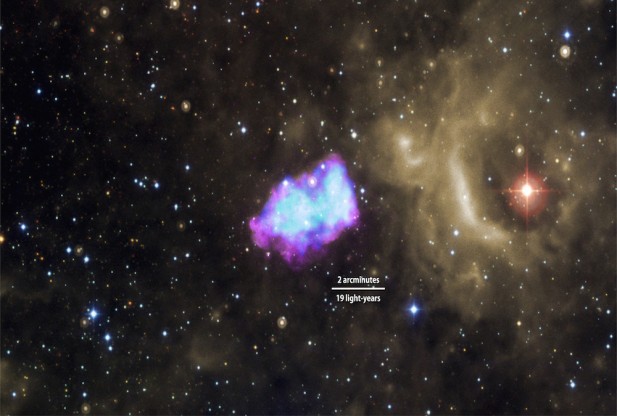
Hiroya Yamaguchi, an astrophysicist at NASA's Goddard Space Flight Center in Maryland, and his colleagues from the US and Japan reviewed observations conducted over five years ago.
"Mounting evidence indicates both of these mechanisms produce what we call type Ia supernovae," Yamaguchi, lead author of a paper published last month in The Astrophysical Journal, said in a statement. "To understand how these stars explode, we need to study the debris in detail with sensitive instruments like those on Suzaku."
A one-man job
According to NASA, supernova remnant 3C 397 is located approximately 33,000 light-years from Earth in the constellation Aquila. Astronomers estimate that this cloud of stellar debris is a middle-aged supernova remnant and has been expanding for between 1,000 and 2,000 years.
Using data collected by Suzaku's X-ray Imaging Spectrometer in October 2010 at energies of between 5,000 and 9,000 electron volts, Yamaguchi's team was able to clearly detect elements that were crucial to weighing the white dwarf. That data, combined with 2005 infrared data from NASA's Spitzer Space Telescope, pointed to a single culprit for the explosion.
The Spitzer observations indicated that 3C 397 had collected a mass approximately 18 times greater than the original white dwarf, meaning that the innermost parts of the stellar remnant would have been thoroughly heated by shock-waves.
What's up with white dwarf stars?
The majority of low- and medium-mass stars will eventually become white dwarfs, compact stars that are about as massive as the sun yet closer in size to Earth. White dwarfs are some of the densest known objects in the universe, exceeded only by black holes and neutron stars.
"White dwarfs remain stable as long as they never tip the scales too closely to 1.4 solar masses," explained Carles Badenes, an assistant professor in the Department of Physics and Astronomy at the University of Pittsburgh and a member of the research team. "White dwarfs near this limit are on the verge of a catastrophic explosion. All it takes is a little more mass."
Previously, astronomers believed that the most likely way for white dwarfs to gain mass would be to accumulate it from a normal, sun-like companion star in a binary system, growing larger and larger until it ultimately exploded. This scenario requires that the companion stars survive, however, and the lack of evidence of their continued existence required an alternate model.
Stellar companions exist - we just need to find them
That alternative model came in the form of the merger scenario, in which the explosion is caused by a pair of lower-mass white dwarfs whose orbits become increasingly closer over time until the duo eventually merge and explode, the US space agency explained.
"We can distinguish which of these scenarios is responsible for a given supernova remnant by tallying the nickel and manganese in the expanding cloud," said Goddard astrophysicist Brian Williams. "An explosion from a single white dwarf near its mass limit will produce significantly different amounts of these elements than a merger."
In the new study, the authors also measured iron and chromium (both of which are produced in all type Ia explosions) in order to standardize their calculations. Their work is part of an ongoing program to better understand the diversity of type Ia supernovae, and suggests that at least some of these supernovae must have surviving stellar companions out there somewhere.



Reader Comments
to our Newsletter